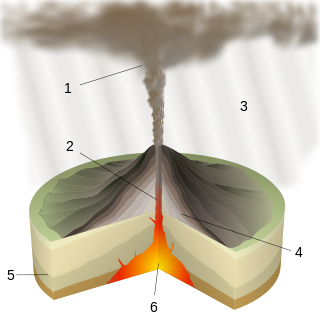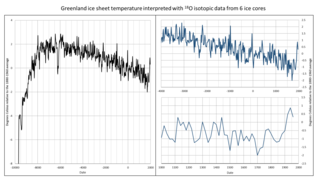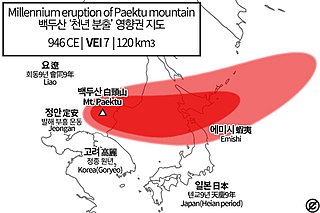Related Research Articles

The 17th century BC was the century that lasted from 1700 BC to 1601 BC.

Mount Vesuvius is a somma-stratovolcano located on the Gulf of Naples in Campania, Italy, about 9 km (5.6 mi) east of Naples and a short distance from the shore. It is one of several volcanoes forming the Campanian volcanic arc. Vesuvius consists of a large cone partially encircled by the steep rim of a summit caldera, resulting from the collapse of an earlier, much higher structure.
The volcanic winter of 536 AD was the most severe and protracted episode of climatic cooling in the Northern Hemisphere in the last 2,000 years. The volcanic winter was caused by at least three simultaneous eruptions of uncertain origin, with several possible locations proposed in various continents. Most contemporary accounts of the volcanic winter are from authors in Constantinople, the capital of the Eastern Roman Empire, although the impact of the cooler temperatures extended beyond Europe. Modern scholarship has determined that in early AD 536, an eruption ejected massive amounts of sulfate aerosols into the atmosphere, which reduced the solar radiation reaching the Earth's surface and cooled the atmosphere for several years. In March 536, Constantinople began experiencing darkened skies and cooler temperatures.

A volcanic winter is a reduction in global temperatures caused by droplets of sulfuric acid obscuring the Sun and raising Earth's albedo (increasing the reflection of solar radiation) after a large, sulfur-rich, particularly explosive volcanic eruption. Climate effects are primarily dependent upon the amount of injection of SO2 and H2S into the stratosphere where they react with OH and H2O to form H2SO4 on a timescale of week, and the resulting H2SO4 aerosols produce the dominant radiative effect. Volcanic stratospheric aerosols cool the surface by reflecting solar radiation and warm the stratosphere by absorbing terrestrial radiation for several years. Moreover, the cooling trend can be further extended by atmosphere-ice-ocean feedback mechanisms. These feedbacks can continue to maintain the cool climate long after the volcanic aerosols have dissipated.

The volcanism of Italy is due chiefly to the presence, a short distance to the south, of the boundary between the Eurasian Plate and the African Plate. Italy is a volcanically active country, containing the only active volcanoes in mainland Europe. The lava erupted by Italy's volcanoes is thought to result from the subduction and melting of one plate below another.

Mount Aniakchak is a 3,600-year-old volcanic caldera approximately 10 kilometers (6 mi) in diameter, located in the Aleutian Range of Alaska, United States. Although a stratovolcano by composition, the pre-existing mountain collapsed in a major eruption forming the caldera. The area around the volcano is the Aniakchak National Monument and Preserve, maintained by the National Park Service. In November 1967, Aniakchak Caldera was designated as a National Natural Landmark by the National Park Service.

Plinian eruptions or Vesuvian eruptions are volcanic eruptions marked by their similarity to the eruption of Mount Vesuvius in 79 AD, which destroyed the ancient Roman cities of Herculaneum and Pompeii. The eruption was described in a letter written by Pliny the Younger, after the death of his uncle Pliny the Elder.
This timeline lists events in the external environment that have influenced events in human history. This timeline is for use with the article on environmental determinism. For the history of humanity's influence on the environment, and humanity's perspective on this influence, see timeline of history of environmentalism. See List of periods and events in climate history for a timeline list focused on climate.

The Minoan eruption was a catastrophic volcanic eruption that devastated the Aegean island of Thera circa 1600 BCE. It destroyed the Minoan settlement at Akrotiri, as well as communities and agricultural areas on nearby islands and the coast of Crete with subsequent earthquakes and paleotsunamis. With a VEI magnitude of a 6, resulting in an ejection of approximately 28–41 km3 (6.7–9.8 cu mi) of dense-rock equivalent (DRE), the eruption was one of the largest volcanic events in human history. Since tephra from the Minoan eruption serves as a marker horizon in nearly all archaeological sites in the Eastern Mediterranean, its precise date is of high importance and has been fiercely debated among archaeologists and volcanologists for decades, without coming to a definite conclusion.
The 1750s BC was a decade lasting from January 1, 1759 BC to December 31, 1750 BC.

The Avellino eruption of Mount Vesuvius refers to a Vesuvian eruption in c. 1995 BC. It is estimated to have had a VEI of 6, making it larger and more catastrophic than Vesuvius's more famous and well-documented 79 AD eruption. It is the source of the Avellino pumice deposits extensively found in the comune of Avellino in Campania.

The Hatepe eruption, named for the Hatepe Plinian pumice tephra layer, sometimes referred to as the Taupō eruption or Horomatangi Reef Unit Y eruption, is dated to 232 CE ± 10 and was Taupō Volcano's most recent major eruption. It is thought to be New Zealand's largest eruption within the last 20,000 years. The eruption ejected some 45–105 km3 (11–25 cu mi) of bulk tephra, of which just over 30 km3 (7.2 cu mi) was ejected in approximately 6–7 minutes. This makes it one of the largest eruptions in the last 5,000 years, comparable to the Minoan eruption in the 2nd millennium BCE, the 946 eruption of Paektu Mountain, the 1257 eruption of Mount Samalas, and the 1815 eruption of Mount Tambora.

The Middle Bronze Age Cold Epoch was a period of unusually cold climate in the North Atlantic region that lasted about from 1800 BC to 1500 BC. It was followed by the Bronze Age Optimum.
The Hekla 3 eruption (H-3) circa 1000 BC is considered the most severe eruption of Hekla during the Holocene. It threw about 7.3 km3 of volcanic rock into the atmosphere, placing its Volcanic Explosivity Index (VEI) at 5. This would have caused a volcanic winter, cooling temperatures in the Northern Hemisphere for several years afterwards.

The London Medical Papyrus is an ancient Egyptian papyrus in the British Museum, London. The writings of this papyrus are of 61 recipes, of which 25 are classified as medical while the remainder are of magic. The medical subjects of the writing are skin complaints, eye complaints, bleeding and burns.

The 946 eruption of Paektu Mountain in Korea and China, also known as the Millennium Eruption or Tianchi eruption, was one of the most powerful volcanic eruptions in recorded history and is classified as a VEI-6 event. The eruption resulted in a brief period of significant climate change in Manchuria. The eruption occurred in late 946 CE.

In 1257, a catastrophic eruption occurred at the Samalas volcano on the Indonesian island of Lombok. The event had a probable Volcanic Explosivity Index of 7, making it one of the largest volcanic eruptions during the Holocene epoch. It left behind a large caldera that contains Lake Segara Anak. Later volcanic activity created more volcanic centres in the caldera, including the Barujari cone, which remains active.

Little Ice Age volcanism refers to the massive volcanic activities during the Little Ice Age. Scientists suggested a hypothesis that volcanism was the major driving force of the global cooling among the other natural factors, i.e. the sunspot activities by orbital forcing and greenhouse gas. The Past Global Change (PAGES), a registered paleo-science association for scientific research and networking on past global changes in the University of Bern, Switzerland, suggested that from 1630 to 1850, a total of 16 major eruptions and cooling events had taken place. When a volcano erupts, ashes burst out of the vent together with magma and forms a cloud in the atmosphere. The ashes act as an isolating layer that block out a proportion of solar radiation, causing global cooling. The global cooling effect impacts ocean currents, atmospheric circulation and cause social impacts such as drought and famine. Wars and rebellions were therefore triggered worldwide in the Little Ice Age. It was suggested that the crisis on Ottoman Empire and Ming-Qing Transition in China were typical examples that closely correlated with Little Ice Age.
Rosanne D'Arrigo is a professor at Lamont–Doherty Earth Observatory at Columbia University known for her research into climate change using dendrochronology, or dating based on tree rings.
References
- ↑ LaMarche, Valmore C. Jr.; Hirschboeck, Katherine K. (1984). "Frost rings in trees as records of major volcanic eruptions". Nature . 307 (5947): 121–126. doi:10.1038/307121a0. S2CID 4370382.
- ↑ Baillie, M. G. L.; Munro, M. A. R. (1988). "Irish tree rings, Santorini and volcanic dust veils". Nature. 332 (6162): 344–346. doi:10.1038/332344a0. S2CID 4286911.
- ↑ Vogel; J. S.; et al. (1990). "Vesuvius/Avellino, one possible source of seventeenth century BC climatic disturbances". Nature. 344 (6266): 534–537. doi:10.1038/344534a0. S2CID 4368499.
- ↑ McAneney, J. & Baillie, M.G.L. (2019). "Absolute tree-ring dates for the Late Bronze Age eruptions of Aniakchak and Thera in light of a proposed revision of ice-core chronologies". Antiquity. 93 (367): 99–112. doi: 10.15184/aqy.2018.165 .